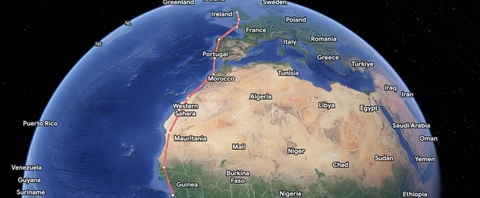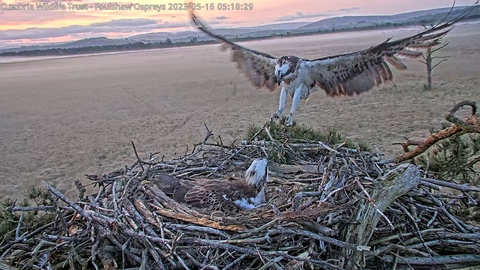Blue 35 and White YW have had another successful summer rearing three healthy young ospreys. They have been amazingly attentive parents carefully nurturing their brood at #FoulshawOspreys.
Looking forward to overwintering in sunnier climes
© Cumbria Wildlife Trust
Foulshaw Ospreys getting ready for their long journey south 2023 (https://youtu.be/ShND_7SsBuc)
© Cumbria Wildlife Trust
Since their young have fledged, the parent birds have continued to feed them. More than likely, both the male and the female parent will now be fishing to ensure the youngsters and the adults are well fed and fit enough to make the long journey south.
There has been no shortage of food this summer with White YW catching an assortment of fish: both freshwater and marine.
A question for you!
For those of you who know the Foulshaw Moss area, one of the places that the ospreys fish is in the Kent estuary at Arnside on the approach to Morecambe Bay.
During the summer months before high tide, there is a siren that sounds to give warning of the approaching surge as the tide rushes in.
One of the wonderful volunteers at the Foulshaw Moss hide had noticed that on a few occasions the ospreys seemed to recognise the siren and flew off the nest when they heard the warning sound. He wonders whether this is because the ospreys associate the siren with plentiful fish supplies with the turning tide or whether it’s just coincidence.
It would be fascinating to know if you've noticed this and have any thoughts you’d like to share with us. Comment below!
The Kent estuary at Arnside just before the turn of the tide.
Getting ready to migrate
Sadly, the live cameras are no longer operating but many eagle eyed watchers and volunteers are keeping an eye on the nest and will log the dates that the birds fly off to sunnier climes.
We would expect female Blue 35 to leave ahead of the family, followed by the youngsters and then the last one to leave will be male White YW.
Unlike most migrating birds, they will all fly separately and find their own ways to their wintering grounds. Even the two adults will not meet again until they return to the nest next spring.
Where do the ospreys migrate to?
Satellite tracking over the past few years has been enormously helpful in following ospreys as they migrate between their breeding sites and wintering grounds.
The ospreys that breed in the UK will typically migrate towards southern Spain and Portugal and then onwards to West Africa.
We would expect the Foulshaw ospreys to make a similar journey, flying south across western France, Spain and Portugal before crossing the Gibraltar straits to Morocco keeping close to the west coast of Africa to reach their wintering grounds in, possibly, Senegal or The Gambia.

This simple track shows the direction that our ospreys will be flying. The actual route and final destination will vary for each bird, but it gives a flavour of the challenges ahead.
Previous sightings of Foulshaw ospreys on migration
We have received reports of previous Foulshaw ospreys in their wintering grounds. Blue V8, hatched in 2016, was spotted in The Gambia; Blue 5N, hatched in 2018, was also seen in The Gambia and Blue 7N, hatched in 2018, was seen in southern Spain.
Our very own Blue 35 was seen in Spain in 2017, kindly captured on video by osprey enthusiast, Alberto Benito.
How do the ospreys know where to go?
The adult ospreys will have made the journey several times before and will be experienced in navigating their way south. However, the juveniles make the perilous journey purely through instinct.
The adult ospreys are faithful to their wintering site just as they are to their nest site so they will return to the same place each year to claim their perch. The young ospreys may take longer to reach their destination, stopping en route to explore and fish until they finally find a suitable location.
The ospreys will travel some 4,000 km (2,485 miles) to make the journey taking between two and four weeks. It’s typical for them to fly 250-300 km (155-185 miles) a day and sometimes at considerable heights
The mysteries of migration
There is still a lot of mystery about migration. We still do not know exactly how birds like the osprey navigate. We think it could be a combination of visual clues (we know they fly more in good clear weather); genetic instinct, and some form of geomagnetic perception, using the earth’s magnetic field to navigate.
Surviving migration
The migration south is a hazardous journey for the young ospreys. They have not had the experience to learn how to navigate their way across oceans or deserts and it really is a flight of chance for them.
Once they are in their wintering site, there are many threats and predators that they need to learn to avoid. Hence, sadly, the survival rate of juvenile ospreys is so low – around 30%.
For those that do survive, they will stay in their wintering grounds for the whole of their second year and will probably begin their migration back to their natal area the following spring.
They will still be immature birds and it is unlikely they will start breeding until a year or two passes when they will look for an available mate and nest to start their own family.
Find out more about osprey migration
If you'd like to know more about osprey migration, have a look at the fascinating Cumbria Wildlife Trust presentation by Paul Waterhouse, Foulshaw Moss Reserve Manager, and leading osprey expert, Tim Mackrill, Founder of Osprey Leadership Foundation and former Project Manager of Rutland Water Osprey Project. The talk was given earlier this year just before the return of Blue 35 and White YW.
You can also find all our osprey blogs with videos and photos to remind you of the amazing life of our 2023 #FoulshawOspreys family.
We wish the Foulshaw osprey family well on their journeys and look forward to seeing them – and you – again next spring.

© Cumbria Wildlife Trust






Comments